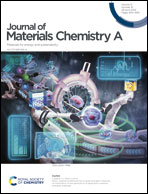Coupling electrocatalytic redox-active sites in a three-dimensional bimetalloporphyrin-based covalent organic framework for enhancing carbon dioxide reduction and oxygen evolution†
Abstract
Constructing bifunctional covalent organic framework (COF) electrocatalysts to mimic photosynthesis independent of natural sunlight is important for the CO2 recycling. We first construct a 3D bifunctional Co/Ni–TPNB-COF containing Ni(II)-porphyrin and Co(II)-porphyrin units linked by 4′,4′′,4′′′-nitrilotris(1,1′-biphenyl) (NB) units. In neutral electrolyte, the Co/Ni–TPNB-COF exhibits both satisfactory oxygen evolution reaction (OER) and carbon dioxide reduction reaction (CDRR) with a CO2-to-CO faradaic efficiency of ∼95% and ultra-high turnover frequency of 4.10 s−1 due to the abundant accessible active sites in the 3D framework. Theoretical calculations and experimental characterization demonstrate that the synergistic effects between the two metallic atoms promote their charge redistribution and modify their d-band structure, contributing to enhanced electrocatalytic activities of the CDRR over Co(II)-porphyrin units and the OER over Ni(II)-porphyrin units. The aqueous Zn–CO2 battery with the Co/Ni–TPNB-COF cathode exhibits a remarkable overall energy efficiency of 90.4%, providing new insights into the design of bifunctional COFs for efficient CO2 utilisation.

- This article is part of the themed collection: Journal of Materials Chemistry A HOT Papers


 Please wait while we load your content...
Please wait while we load your content...